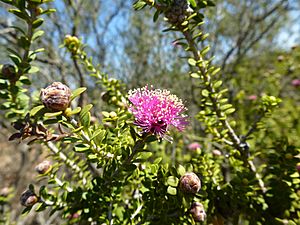Melaleuca amydra facts for kids
Quick facts for kids Melaleuca amydra |
|
|---|---|
 |
|
| M. amydra growing near Eneabba. | |
| Scientific classification | |
| Genus: |
Melaleuca
|
| Species: |
amydra
|
Melaleuca amydra is a unique plant that belongs to the myrtle family. You can only find it growing in the south-west part of Western Australia. This plant looks a lot like another one called Melaleuca ryeae. It's usually small and compact, with oval-shaped leaves. In spring, it grows pretty pink to purple flowers that look like "pom-poms" at the ends of its branches.
Contents
What Melaleuca Amydra Looks Like
Melaleuca amydra is often a small plant, but it can sometimes grow up to 2.5 m (8 ft) tall. It has dark, rough bark. Its leaves are arranged one after another along the stem. They are shaped like ovals or eggs. Each leaf is usually about 3.5–6 mm (0.1–0.2 in) long and 1.5–2 mm (0.06–0.08 in) wide. Some leaves are smooth, while others have tiny hairs. All the leaves have rounded ends.
The flowers of Melaleuca amydra are pink to purple. They grow in round clusters at the tips of the branches. These branches keep growing even after the flowers bloom. Sometimes, flowers also appear where the upper leaves meet the stem. Each flower cluster can be up to 20 mm (0.8 in) across. Inside each cluster, there are between 7 and 20 individual flowers. The flowers have five groups of stamens (the parts that make pollen), with 5 to 10 stamens in each group.
This plant blooms in spring. After the flowers fade, they turn into small, woody fruits. These fruits are like capsules, about 3–3.5 mm (0.12–0.14 in) long. They grow in messy bunches along the stems.
How Melaleuca Amydra Got Its Name
The plant Melaleuca amydra was officially described in 1999. Two scientists, Lyndley Craven and Brendan Lepschi, gave it its name. They wrote about it in a science journal called Australian Systematic Botany. They found a sample of the plant near Eneabba.
The second part of its scientific name, amydra, comes from an ancient Greek word. Amydros means "indistinct" or "unclear." This name was chosen because Melaleuca amydra is very similar to two other plants: M. ryeae and M. seriata. It's hard to tell them apart!
Where Melaleuca Amydra Lives
This type of melaleuca plant grows in a few specific areas in Western Australia. You can find it around the Arrowsmith River, Dandaragan, and Moora districts. These areas are part of different natural regions, including the Avon Wheatbelt, Geraldton Sandplains, and Swan Coastal Plain.
Melaleuca amydra likes to grow in sandy soil that can be a bit salty. It often lives in flat, open areas with low-growing shrubs, which are called heathlands.
Conservation Status
The Government of Western Australia's Department of Parks and Wildlife keeps track of how many of these plants are left. They have classified Melaleuca amydra as "not threatened." This means there are enough of these plants in the wild, and they are not currently at risk of disappearing.
Images for kids




